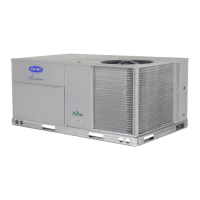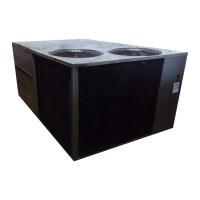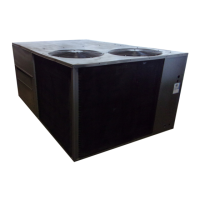42
Thermostats
The EconoMi$er IV control works with conventional
thermostats that have a Y1 (cool stage 1), Y2 (cool stage
2), W1 (heat stage 1), W2 (heat stage 2), and G (fan). The
EconoMi$er IV control does not support space
temperature sensors. Connections are made at the
thermostat terminal connection board located in the main
control box.
Occupancy Control
The factory default configuration for the EconoMi$er IV
control is occupied mode. Occupied status is provided by
the black jumper from terminal TR to terminal N. When
unoccupied mode is desired, install a field--supplied
timeclock function in place of the jumper between TR and
N. When the timeclock contacts are closed, the
EconoMi$e r IV control will be in occupied mode. Whe n
the timeclock contacts are open (removing t he 24V signal
from terminal N), the EconoMi$er IV will be in
unoccupi ed mode.
Demand Control Ventilation (DCV)
When using the EconoMi$er IV for demand controlled
ventilation, there are some equipment selection criteria
which should be considered. When selecting the heat
capacity and cool capacity of the equipment, the
maximum ventilation rate must be evaluated for design
conditions. The maximum damper position must be
calculated to provide the desired fresh air.
Typically the maximum ventilation rate will be about 5 to
10% more than the typical cfm required per person, using
normal outside air design criteria.
A proportional anticipatory strategy should be taken wit h
the following conditions: a zone with a large area, varied
occupancy, and equipment that cannot exceed the required
ventilation rate at design c onditions. Exceeding the
required ventilation rate means the equipment can
condition air at a maximum ventilation rate that is greater
than the required ventilation rate for maximum
occupa ncy. A proportional-anticipatory strategy will cause
the fresh air supplied to increase as the room CO
2
leve l
incre ases even though the CO
2
setpoint has not been
reached. By the time the CO
2
level reaches the setpoint,
the damper will be at maximum ventilation and should
maintain the setpoint.
In order to have the CO
2
sensor control the economizer
damper in this manner, first determine the damper voltage
output for minimum or base ventilation. Base ventilation
is the ventilation required to remove contaminants during
unoccupi ed peri ods. The following equation may be used
to determine the percent of outside air entering the
building for a given damper position. For best results there
should be at least a 10 degree difference in outside and
return-air temperatures.
(T
Ox
OA
)
+(TR
x
RA
)=T
M
100 100
T
O
= Outdoor-Air Temperature
OA = Perc ent of Outdoor Air
T
R
= Return-Air Temperature
RA = Percent of Return Air
T
M
= Mixed-Air Temperature
Once base ventilation has been determined, set the
minimum damper position potentiometer to the correct
position.
The same equation can be used to determine the occupied
or maximum ventilation rate to the building. For example,
an output of 3.6 volt s to the actuator provides a base
ventilation rate of 5% and an output of 6.7 volts provides
the maximum ventilation rate of 20% (or base plus 15 cfm
per person). Use Fig. 56 to determine the m aximum
setting of the CO
2
sensor. For example, an 1100 ppm
setpoint relates to a 15 cfm per person design. Use t he
1100 ppm curve on Fig. 56 to find the point when the CO
2
sensor out put will be 6.7 volts. Line up the point on the
graph with the left side of the chart to determine that the
range configuration for the CO
2
sensor should be 1800
ppm. The EconoMi$er IV controller will output the 6.7
volts from the CO
2
sensor to the a ctuator when the CO
2
conce ntration in the space is at 1100 ppm. The DCV
setpoint may be left at 2 volts since the CO
2
sensor
voltage will be i gnored by the EconoMi$er IV c ontroller
until it rises above the 3.6 volt setting of the minimum
position potentiometer.
Once the fully occupied damper position has been
determined, set the maximum damper demand control
ventilation potentiometer to this position. Do not set to the
maximum position as this can result in over-ventilation to
the space and potential high humidity levels.
CO
2
Sensor Configuration
The CO
2
sensor has preset standard voltage settings that
can be selected anytime after the sensor is powered up.
See Table 10.
Use setting 1 or 2 for Carrier equipment. See Table 10.
1. Press Clear and Mode buttons. Hold at least 5
seconds until the sensor enters the Edit mode.
2. Press Mode twice. The STDSET Menu will appear.
Table 10 – EconoMi$er IV Sensor Usage
APPLICATION
ECONOMI$ER IV WITH OUTDOOR AIR DRY
BULB SENSOR
Accessories R equired
Outdoor Air
Dry Bulb
None. The outdoor air dry bulb sensor is
factory installed.
Differential
Dry Bulb
CRTEMPSN002A00*
Single Enthalpy HH57AC078
Differential
Enthalpy
HH57AC078 and CRENTDIF004A00*
CO
2
for DCV
Control using a
Wall-Mounted
CO
2
Sensor
33ZCSENCO2
CO
2
for DCV
Control using a
Duct-Mounted
CO
2
Sensor
33ZCSENCO2† and
33ZCASPCO2**
O
R
CRCBDIOX005A00††
* CRENTDIF004A00 and CRTEMPSN002A00 accessories are
used on many different base units. As such, these kits may
contain parts that will not be needed for installation.
† 33ZCSENCO2 is an accessory CO
2
sensor.
** 33ZCASPCO2 is an accessory aspirator box required for duct-
mounted applications.
†† CRCBDIOX005A00 is an accessory that contains both
33ZCSENCO2 and 33ZCASPCO2 accessories.
50HC

